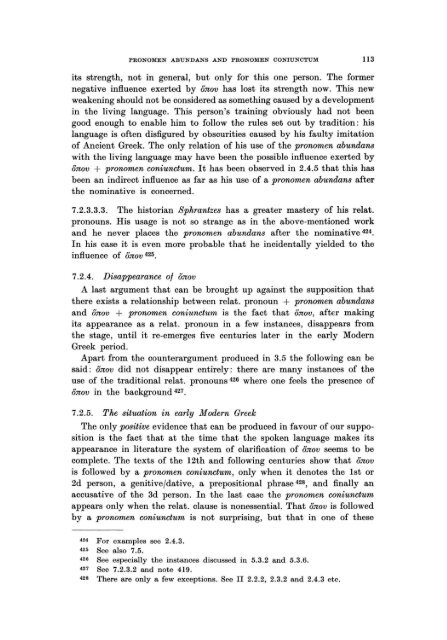Pronomen Abundans and Pronomen Coniunctum. A ... - DWC
Pronomen Abundans and Pronomen Coniunctum. A ... - DWC
Pronomen Abundans and Pronomen Coniunctum. A ... - DWC
Create successful ePaper yourself
Turn your PDF publications into a flip-book with our unique Google optimized e-Paper software.
PRONOMEN ABUNDANS AND PRONOMEN CONIUNCTUM 113<br />
its strength, not in general, but only for this one person. The former<br />
negative influence exerted by önov has lost its strength now. This new<br />
weakening should not be considered as something caused by a development<br />
in the living language. This person's training obviously had not been<br />
good enough to enable him to follow the rules set out by tradition : his<br />
language is of ten disfigured by obscurities caused by his faulty imitation<br />
of Ancient Greek. The only relation of his use of the pronomen abundans<br />
with the living language may have been the possible influence exerted by<br />
önov + pronomen coniunctum. It has been observed in 2.4.5 that this has<br />
been an indirect influence as far as his use of a pronomen abundans af ter<br />
the nominative is concerned.<br />
7.2.3.3.3. The historian Sphrantzes has a greater mastery of his relat.<br />
pronouns. His usage is not so strange as in the above-mentioned work<br />
<strong>and</strong> he never pI aces the pronomen abundans af ter the nominative 424.<br />
In his case it is even more probable that he incidentally yielded to the<br />
influence of O:ltOV 425.<br />
7.2.4. Disappearance ot önov<br />
A last argument that can be brought up against the supposition that<br />
there exists a relationship between relat. pronoun + pronomen abundans<br />
<strong>and</strong> önov + pronomen coniunctum is the fa ct that onov, af ter making<br />
its appearance as arelat. pronoun in a few instances, disappears from<br />
the stage, until it re-emerges five centuries later in the early Modern<br />
Greek period.<br />
Apart from the counterargument produced in 3.5 the following can be<br />
said: onov did not disappear entirely: there are many instances of the<br />
use of the traditional relat. pronouns 426 where one feels the presence of<br />
onov in the background 427 .<br />
7.2.5. The situation in early Modern Greek<br />
The only positive evidence that can be produced in favour of our supposition<br />
is the fa ct that at the time that the spoken language makes its<br />
appearance in literature the system of clarification of onov seems to be<br />
complete. The texts of the 12th <strong>and</strong> following centuries show that onov<br />
is followed by a pronomen coniunctum, only when it denotes the lst or<br />
2d person, a genitivejdative, a prepositional phrase 428, <strong>and</strong> finally an<br />
accusative of the 3d person. In the last case the pronomen coniunctum<br />
appears only when the relat. clause is nonessential. That onov is followed<br />
by a pronomen coniunctum is not surprising, but that in one of these<br />
424 For examples see 2.4.3.<br />
425 See also 7.5.<br />
426 See especially the instances discussed in 5.3.2 <strong>and</strong> 5.3.6.<br />
427 See 7.2.3.2 <strong>and</strong> note 419.<br />
428 There are onIy a few exceptions. See II 2.2.2, 2.3.2 <strong>and</strong> 2.4.3 etc.
















